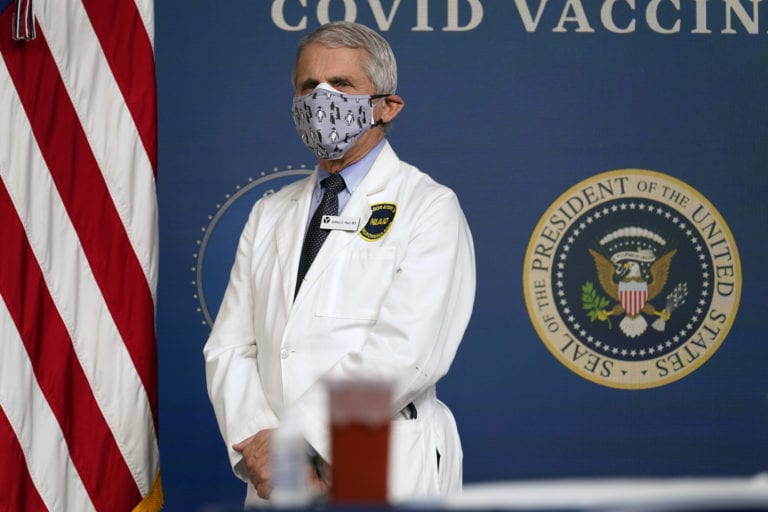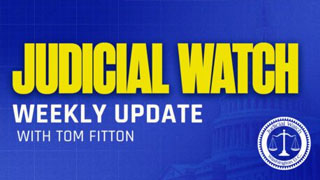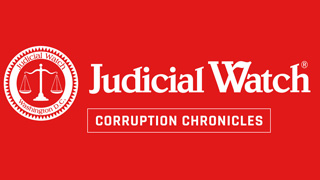
Judicial Watch: New Fauci Agency COVID Emails Detail Discussions about Wuhan Institute; Describe Gates Foundation Placement of Chinese Representatives on ‘Important International Counsels’

(Washington, DC) – Judicial Watch announced today that it received 129 pages of records from the Department of Health and Human Services (HHS) which include “urgent for Dr. Fauci ” email chain which cites ties between the Wuhan lab and the taxpayer-funded EcoHealth Alliance. The government emails also report that the foundation of U.S. billionaire Bill Gates worked closely with the Chinese government to pave the way for Chinese-produced medications to be sold outside China and help “raise China’s voice of governance by placing representatives from China on important international counsels as high level commitment from China.”
The new production of records also includes a January 6, 2020, “Wuhan Pneumonia Update” report which details how Peter Daszak, president of EcoHealth Alliance, was tied to the Wuhan lab and was “funded for work to understand how coronaviruses evolve and jump to human populations.”
The documents were obtained by Judicial Watch through a Freedom of Information Act (FOIA) lawsuit for records of communications, contracts and agreements with the Wuhan Institute of Virology (Judicial Watch, Inc. v. U.S. Department of Health and Human Services (No. 1:21-cv-00696)). The lawsuit specifically seeks records about NIH grants that benefitted the Wuhan Institute of Virology. The agency is only processing 300 pages of records per month, which means it will take until the end of November for the records to be fully reviewed and released under FOIA.
The new emails include a report from Dr. Ping Chen, who had been the top Fauci agency official working in China:
You can ask [NIAID Human Coronavirus, Rhinovirus Research Program Officer] Erik Stemmy for the grant awarded to the Ecohealth in NYC who collaborates with Dr. Shi, Zhengli in Wuhan Institute of Virology (WIV), who has been doing coronavirus research in cave bats in China. Erik would know what exactly NIH funding supports.
I visited her and others at the Wuhan Ins Viro in 2018 and visited its BSL4 1ab. [Redacted]
Also in 1983 NIH and CAS [Chinese Academy of Sciences] (WIV is one of the research institutes under CAS) signed a MOU and it included sharing research materials. I know [sic] this a long time ago.
This email chain is part of a previously released January 23, 2020, exchange with the subject line “Urgent for Dr. Fauci: China’s lab for studying SARS and Ebola is in Wuhan.” It begins with Melinda Haskins, chief of legislative affairs for NIAID, writing to senior NIAID officials, and includes a link to a Daily Mail article, titled “China built a lab to study SARS and Ebola in Wuhan – and US biosafety experts warned in 2017 that a virus could ‘escape’ the facility that’s become key in fighting the outbreak.” She writes: “Dr. Fauci will be brief [sic] multiple Senators tomorrow on our novel coronavirus response … Would you please confirm the exact nature of our support to the Wuhan Institute of Virology/Biosafety Lab. You’ll want to read the Daily Mail article above.”
A January 6, 2020, email exchange on “coronavirus countermeasures,” initiated by NIAID Chief Medical Officer Hilary Marston, includes a “Wuhan Pneumonia Update” report prepared by NIH/DMID.
The report was updated on January 8, 2020, and lists in its background information on “Wuhan Pneumonia:”
- In December 2019 the Wuhan Municipal Health Committee identified an outbreak of viral pneumonia cases of unknown cause.
- On December 31st the WHO China Country Office was notified of 44 patients with pneumonia of unknown etiology, 11 of which were severely ill.
- As of January 5th, 2020 there are 59 patients with a diagnosis of unknown viral pneumonia is Wuhan, 7 of which are severely ill. At least one patient is on ECMO … The earliest case was reported December 12th, and the latest onset was December 29th. All patients are isolated and receiving treatment in Wuhan medical institutions. 163 close contacts have been identified for ongoing medical observation.
- Case-patients in the outbreak are reported to have fever, difficulty breathing, and bilateral lung infiltrates on chest radiography (CDC, http://bit.ly/36GxY3y).
- Hong Kong has added Wuhan Pneumonia to the list of notifiable diseases. As of January 7th, 2020 the Hong Kong Center for Health Protection has reports of 30 cases under enhanced surveillance with recent travel history to Wuhan….
- Epidemiological investigation showed that some patients operated businesses in the Wuhan South China Seafood City. As of January 1st, 2020 the market has been closed for environmental sanitation and disinfection.
- There is currently no clear evidence of human-to-human transmission, however one family cluster has been identified. No nosocomial transmission has been seen …
- Fragments of coronavirus RNA with an 86% homology to SARS has been found in one patient…
- News reports on 1/8/2020 the virus is a novel coronavirus, sequenced in one patient and identified in others.
The report also details a NIH coronavirus grant “portfolio” that funded 13 basic science research grants, two treatment research grants and five vaccination research grants related to coronavirus:
Peter Daszak (R01A|110964-06) is funded for work to understand how coronaviruses evolve and jump to human populations, with an emphasis on bat CoVs and high-risk populations at the human-animal interface. Main foreign sites are in China (including co-investigators at the Wuhan Institute of Virology).
The report notes that one of the grants, made to Fang Li, “is funded to investigate the receptor recognition and cell entry in coronaviruses using structural approaches using spike proteins in complex with receptors. This award found the first evidence of a MERS-related CoV that uses the human receptor and provides evidence of a natural recombination event between bat CoVs.” Another grant involves “a team of investigators using mouse models of SARS and MERS to investigate CoV pathogenesis and develop vaccines and therapeutics.”
A section of the report on “Vaccines” details:
“The VRC [Vaccine Research Center] and collaborators have stabilized the MERS-CoV spike protein in its prefusion conformation. The stabilized spike protein is potently immunogenic and elicits protective antibodies to the receptor binding domain, n-terminal domain and other surfaces of the spike protein. The stabilized coronavirus spike protein, and mRNA expressing the spike protein through collaboration with Moderna Therapeutics, is currently being evaluated in the humanized DPP4 mouse model at UNC.
Another grant description indicates that NIH was funding research at Jefferson University using the rabies virus as a vector to deliver a potential vaccine. In an accompanying spreadsheet detailing the grants, one grant is listed as having gone to Dr. Ralph Baric of UNC-Chapel Hill to study “Mechanisms of MERV-CoV Entry, Cross Species Transmission and Pathogenesis.” That grant had been funded from 2015-2020.
In a January 7, 2020, email exchange with the subject line “Wuhan Pneumonia” Stemmy asks Chen if she has any information about the “viral pneumonia outbreak in Wuhan.” Chen replies: “Yes, I have been following the news. Here is what I know so far [redacted]. Chen also revealed that her tour in Beijing had ended three weeks earlier.
Stemmy asks, “Do you know if there is a replacement for you in embassy in Beijing? If so I’d love to connect with them.” Chen replies, “No replacement for now <smiley face emoji>.”
In a January 22, 2020, email exchange titled “Collecting info on N CoV [novel coronavirus]”, NIAID “Senior Volunteer”, Dr. Karl Western, informs Chen and other NIAID officials:
Two recent examples involving CAS Institute of Virology and BSL-4 facility include:
- University of Minnesota and CAS Institute of Virology review of the origin and evolution of pathogenic coronaviruses in Nature Reviews: Microbiology. Minnesota had a CEIRS award for one funding cycle.
- Columbia University School of Public Health, Eco-Health Alliance and CAS Institute of Virology published a few days ago on the results of surveillance of human animal interactions and bat coronavirus spillover potential in rural southern China. Columbia is a current CETR holder.
In a heavily redacted response email, Chen writes: “Thanks Dr. Western. Eco-health has NIAID grant which has collaboration with the Wuhan Institute of Virology, CAS, studying the coronaviruses in wild animals, focusing on bats, in China. One of the key Chinese collaborators is Dr. Zhengli Shi, who works on coronaviruses.”
On February 6, 2020, Han Koo, an executive assistant to the Director of NIH who works in the Office of Grants Administration (OGA), emails Chen and Matthew Brown, then-Director of the NIH China Office: “We need POCs [points of contact] of the National Natural Science Foundation of China (NSFC) and The Chinese Academy of Science (CAS) ASAP.”
Later in the chain Chen writes: “In 2018, NSF [the U.S. National Science Foundation] and NSFC [the National Science Foundation of China] had a joint initiative on Ecology and Evolution of infectious diseases. A workshop was held prior to the initiative (NIH is one of the participants to this initiative. Many participants of the workshop are from CAS institute including WIV [Wuhan Institute of Virology] scientists. NIAID grant to EcoHealth is studying coronaviruses in animals including bats. The grant has different countries as collaborators in addition to China.” A colleague then responds: “Thanks! Do you recall who the US and Chinese PIs [principal investigators] are on that coronavirus vector/reservoir grant are?” Chen replies: “See the attachment I prepared previously. This grant is on bat [redacted].”
In an October 20, 2017, email exchange following Chen’s submission of a situation report, NIAID official James Meegan tells Chen: “Jim LeDuc at U Texas Medical Branch, Director of the Galveston BSL4, works closely with them [Wuhan Institute of Virology]. In 1986 Jim and I spent the year on and off in Wuhan setting up a virology lab and studying Hantavirus infections and treating patients with ribavirin. We trained many, and some later came to the States. I think that helped it on its way to becoming a center for virology.”
Further in the exchange, Chen writes, “The [Wuhan] lab will be operational soon. The visit has been arranged through one of our grantees. I know Jim LeDuc has been worked with WIV and had done some training. [Redacted.] Also, I was told only certain viruses can be worked in this lab. [Redacted]” Handley then tells Chen: “Please make a very careful and full report on what you learn during this visit. It will be a very important interaction and one that many are interested in. Please share your report with us before it goes into any other reporting. We will be glad to engage directly or via grantees in whatever will help ensure safe operations.”
On March 4, 2020, Greg Folkers, Fauci’s chief of staff, emails an academic paper titled “On the origin and continuing evolution of SARS-COV-2”, published in National Science Review on March 3, 2020, to David Morens and other unidentified officials within NIAID, and asks in his cover note: “David, this may come up in ASF’s [Anthony S. Fauci’s] 10:00 hearing [likely referring to House Appropriations Committee hearings held on March 4, 2020, on NIH budget requests.] What do you make of this paper and the attendant press coverage?” Folkers highlights within the report two passages. One reads: “Our results suggest that the development of the new variations in functional sites in the receptor-binding domain (RBD) of the spike seen in SARS-COV-2 and viruses from pangolin SARS-CoVs are likely caused by mutations and natural selection besides recombination.” The second highlighted passage reads: “Although the L type (~70%) is more prevalent than the S type (~30%), the S type was found to be the ancestral version. Whereas the L type was more prevalent in the early stages of the outbreak in Wuhan, the frequency of the L type decreased after early January 2020.” Morens replied, but his response is entirely redacted.
Five years prior to the outbreak, in an October 30, 2014, report titled “Wuhan,” Chen informs Ken Earhart that she had met with a Chinese official from Wuhan. Chen reports that his office “is similar to what I am doing here seeking, facilitating, and promoting international scientific collaborations for scientists in Wuhan.” She continues that this official was asked by an organization put together in part by the Wuhan Institute of Virology “to help the members in the organization increase scientific exchanges between the members and international ID [infectious disease] experts.”
In a September 5, 2017, situation report, Chen informs her colleagues that she had “attended a ‘Belt and Road’ High Level Meeting for Health Cooperation: towards a Health Silk Road.” She also reported:
Last week USAID, CDC, ESTH [Environment, Science, Technology, and Health] and I met with Gates Foundation, initially planned to talk about global Malaria eradication efforts to see if there is any area we can work together. But we ended talking in general Chinese policies and the foundation’s current strategies in China — capacity building to help China raise its national standards and leverage China’s resource to help others. One of the examples for raising the national standards is to help China FDA for its reform. Gates foundation has managed to work out a mechanism with China FDA to provide fund[ing] to China FDA for placing experienced Chinese-Americans who had worked at US FDA for many years to work in China FDA as senior consultants….
On the approach for leveraging China’s resource to help others, Gates Foundation is working with Chinese government on donations to its neighboring countries and African countries such as anti-malaria medicines, bed nest, diagnostics etc. More specifically, it helps Chinese companies to gain pre-qualification on medications so that Chinese company manufactured drugs can be sold outside China, helps the Chinese to establish bilateral collaboration with specific countries in Africa, teaches the Chinese how to do resource mobilization, and helps raise China’s voice of governance by placing representatives from China on important international counsels as high level commitment from China.
Chen goes on to describe numerous other ways the Gates Foundation was helping the Chinese government by, for example, helping “Chinese companies gain pre-qualification on medications so that Chinese company manufactured drugs can be sold outside China.” Chen continues: “Just met with a group from the Global Virome Project (GVP) which is funded partially by USAID. The head of the project, Peter Daszak of EcoHealth Alliance, is an NIAID funded PI. His collaborator at the Wuhan Institute of Virology in China has done excellent work on corona viruses in Chinese bat populations.”
A heavily redacted October 26, 2017, email released to Judicial Watch in a previous production includes a newly released response from Handley. The email chain begins with Chen sending a trip report to her colleagues regarding her visit to the BSL4 Lab in Wuhan. She notes: “My contact who helped arrange the visit is Dr. Zhengli Shi, who is a Chinese collaborator on a NIAID grant to EcoHealth for SARS like corona virus project.” She continues: “The P4 lab is located in a new developing zone about one hour car ride from the current institute location in central Wuhan city. The location will be the new campus for the entire institute in the near future (a lot of construction is going on right now). Since we are not allowed to take photos so only the photo from the outside is attached.”
Newly released in this production of HHS documents is Handley’s reply in the email chain: “This is a sensitive subject and will be of interest to others.”
Later in the exchange, Handley tells Chen, “Please send us by e-mail your full report on the visit and then we can decide what to do with the information.” After Chen emails Handley the report, he writes: “There is enough good information in your report that it needs to be shared in some form or another.”
On July 18, 2016, Chen sends an “activity update” to top NIAID officials, summarizing her activities for the prior three weeks. In a discussion of the Chinese needing assistance with conducting clinical trials of new medicines, Chen notes: “GSK’s [Glaxo Smith Kline’s] Zhi Hong (the head of the GSK anti-infective program and led the GSK center for infectious diseases and public health in Beijing) met with Dr. Fauci on Monday, the 11th, asking for NIAID support for this clinical trial network in China. I know Dennis [presumably Dennis Dixon, Chief of NIAID Bacteriology and Mycology] and Carl [possibly Carl Dieffenbach, Director of NIAID AIDS Research] attended the meeting with Fauci. I don’t know the outcome of the meeting.” Further along, Chen writes: “I met with EcoHealth Alliance, a NY based non-profit organization on health. They have a R01 grant from DMID [Division of Microbiology and Infectious Diseases] on identifying SARS-like coronaviruses in China. They partner with Dr. Shi Zhengli at Wuhan Institute of Virology. I visited Dr. Shi over a year ago. She took bat samples in caves in certain regions of China, isolated and identified viruses and found some viruses are similar to SARS by sequencing. Now [redacted]. We are talking about close animal-human close contact in densely populated city.” Chen also mentions an upcoming meeting of “Chinese NIH Alumni” and talks about NIH Director Francis Collins discussing with the head of Peking University Medical School “about the establishment of a Chinese NIH Alumni as there are so many Chinese researchers trained and worked at NIH in the past.”
On October 12, 2016, Chen sends a “High” importance email to senior NIAID officials Handley, Bernabe and Dixon regarding an upcoming conference in China. Chen notes: “Another topic under session 1, Zoonotic Disease Characterization and Prevention, has some relevance to us. NIAID funded George Gao at CAS [Chinese Academy of Sciences] for avian flu (I think it was on avian flu genetics in birds) and we have grant from RDB funding coronavirus survey in bats. The Chinese collaborator is Wuhan Institute of Virology, a CAS institute too. The request for zoonotic diseases is from a Chinese agency I don’t know, AQSIQ. [Redacted.]” Dixon replies: “Thanks Ping. I see the topic of ‘prevention and control’ by your name. While we have occasional projects in that realm, they are at the border of our mission area relative to CDC who list their name that way sometimes in reverse order.”
In a January 20, 2017, situation report, Chen discusses the Global Virome Project “to identify viruses present in wildlife with potential crossing over to humans … Following the identification of the viruses is the development of vaccines to protect human population. China has huge capacity for vaccine development (I think it has 7 national owned vaccine manufacturing facility and over 30 private vaccine making companies.) [Redacted] One of the partners in this project is EcoHealth Alliance. Peter Daszak from EcoHealth Alliance is one of the leaders of GVP and he has NIAID grant from RDB looking at the coronaviruses in bat populations in China in collaboration with Wuhan Institute of Virology. He came to visit me once in the Embassy. This grant has direct connection with the purpose of GVP.”
In a July 7, 2017, situation report, Chen informs her colleagues: “RDB [NIAID’s Respiratory Disease Branch] has a grant to EcoHealth which has a Chinese collaborator at WIV working on finding similar SARS viruses in bat populations and then look for human exposures to the viruses carried by the bats in the villagers near the caves. USAID funds the same organization and they do more virus seeking projects in China.”
On May 27, 2018, Chen emails colleague Nancy Boyd, forwarding her an announcement sent to Chen by people at the Wuhan Institute of Virology, which Chen describes as “China’s only publicly known P4 lab.” Chen adds: “I copied Gayle [Bernabe] at OGR and she can forward to programs officers with the P4 pathogen portfolio.”
“These emails provide extraordinary and troubling information about Fauci’s agency partnership with China and its monitoring, concerns and funding for the Wuhan Institute,” said Judicial Watch President Tom Fitton. “The Gates Foundation should also explain the government report about its assistance to and advocacy for China.”
In July, Judicial Watch obtained records from NIAID officials in connection with the Wuhan Institute of Virology revealing significant collaborations and funding that began in 2014. The records revealed that NIAID gave nine China-related grants to EcoHealth Alliance to research coronavirus emergence in bats and was the NIH’s top issuer of grants to the Wuhan lab itself.
In June, Judicial Watch announced that it filed Freedom of Information Act (FOIA) lawsuits against the Office of the Director of National Intelligence (ODNI) and the State Department for information on the Wuhan Institute of Virology and the origins of the SARS-CoV-2 virus.
Also in June, Judicial Watch obtained records from HHS revealing that from 2014 to 2019, $826,277 was given to the Wuhan Institute of Virology for bat coronavirus research by the NIAID.
In March, Judicial Watch publicly released emails and other records of Fauci and Dr. H. Clifford Lane from HHS showing that NIH officials tailored confidentiality forms to China’s terms and that the WHO conducted an unreleased, “strictly confidential” COVID-19 epidemiological analysis in January 2020. Additionally, the emails reveal an independent journalist in China pointing out the inconsistent COVID numbers in China to NIH’s National Institute of Allergy and Infectious Diseases’ Deputy Director for Clinical Research and Special Projects Lane.
In October 2020, Judicial Watch uncovered emails showing a WHO entity pushing for a press release, approved by Fauci, “especially” supporting China’s COVID-19 response.
###
















